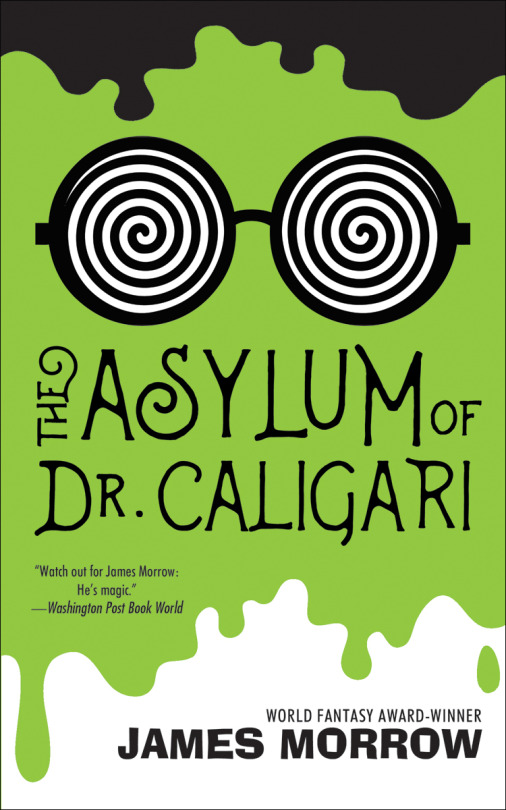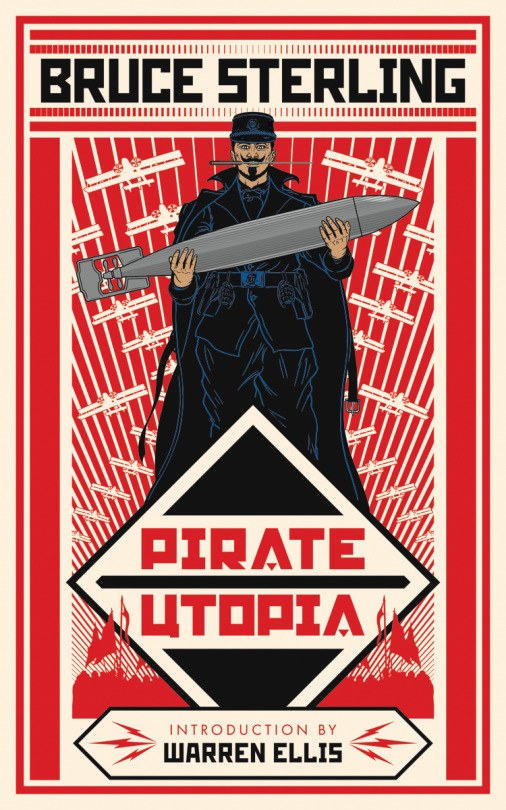James Morrow’s THE ASYLUM OF DR. CALIGARI is a timeless lesson about megalomaniacs, art, science and love
More reviews for James Morrow’s exquisite, inventive THE ASYLUM OF DR. CALIGARI.

At LOCUS ONLINE, Paul Di Filippo enjoys the novella.
Morrow’s solid,
colorful evocation of the era is matched only by his portraiture of
the zany cast. Even Wyndham, ostensibly mundane and anchored, soon
partakes of the madness-that-is-truth. I was particularly enamored of
Ilona’s constant stream of spoonerisms and Carrollian wordplay, but
she is not alone in turning out a neat phrase. Some of the dialogue
assumes a Ballardian flavor of slightly askew non-sequiturs,
gnomically issued. The conceit of the psychically potent artwork
fashioned by Caligari brings to mind, of course, Monty Python’s
famous “Funniest Joke in the World” skit. But Morrow deftly
layers in even more allusiveness. Of course, any madhouse-centric
novel in this era has to tip the hat to ONE FLEW OVER THE CUCKOO’S
NEST. But I also detect some kinship with John Barth’s THE END OF
THE ROAD, as well as to some of the Gothic tales of E. T. A. Hoffman.
But any such nods are discreet and counterbalanced by Morrow’s own
unique conceptions and delivery. THE ASYLUM OF DR. CALIGARI succeeds
in being at once a brilliant rendering of an antique spooky passion
play and a timeless lesson about megalomaniacs, art, science and
love.
STRANGE ALLIANCES praises the story.
THE ASYLUM OF DR. CALIGARI is exquisite, inventive madness of epic proportions, laced with wicked humour.

To me THE ASYLUM OF DR. CALIGARI comes under the same category of taking something and running with it as Bruce Sterling’s splendidly off kilter PIRATE UTOPIA, published last year by Tachyon Publications. Both authors allow the strange to get stranger, yet never once losing control of the plot or where it is going. The two books should sit side by side on their own shelf, lest the energy radiating from them knocks the rest of your collection flying.
Angela Matano for CAMPUS CIRCLE includes the book among their best summer reads.
In THE ASYLUM OF DR. CALIGARI, science fiction’s premier satirist, James Morrow, riffs off the titular silent film for an inventive adventure story that explores the madness of war and the power of art.
MYLIFEMYBOOKSMYESCAPE interviews Morrow.
DJ: What is THE ASYLUM OF DR. CALIGARI about?
JM: Beyond all my scoffing at religion, much of my oeuvre critiques the popular notion that war is a good way for human beings to solve their problems. Back in 1986 I published This Is the Way the World Ends, mocking the Reagan Administration’s nuclear saber-rattling. The plot concerns “the unadmitted,” hypothetical humans whose lives were canceled when their would-be ancestors extinguished themselves in World War III. The unadmitted end up putting the perpetrators of Armageddon on trial, under the Nuremberg precedent, for crimes against the future.
Then came my stand-alone novella SHAMBLING TOWARDS HIROSHIMA, set in 1945 and keyed to the conceit that the U.S. Navy has developed biological weapon that strangely anticipates Godzilla. My hero, based on the horror-film actor Lon Chaney, Jr., must put on a lizard suit and demonstrate this horrendous biotechnology before a Japanese delegation.
In THE ASYLUM OF DR. CALIGARI, I take potshots at war profiteering. Most of the action unfolds at the fictional Träumenchen Asylum during the early months of World War I. The title character, who happens to be a sorcerer, has created a jingoistic oil painting so hypnotic it can compel entire regiments to rush headlong into battle. The plot turns on the efforts of my hero, Francis Wyndham, an art therapist at Träumenchen, and his most gifted pupil, the supernaturally talented Ilona Wessels, to defeat Caligari’s wicked masterpiece with a Guernica-like painting of their own.

DJ: What was your favorite aspect of writing THE ASYLUM OF DR. CALIGARI?
JM: Whenever I’m in the middle of a novel or short story, I convince myself I can draw creative energy from thematically related DVDs. My Caligari project gave me an excuse to screen all sorts of wonderfully ridiculous movies. The Glynis Johns thriller CABINET OF DR. CALIGARI(1960) is pretty lame, despite a script by Robert Bloch, but in the context of my pseudo-research I found some things to admire about it (especially Dan O’Herlihy’s virtuoso performance). Then there was Roy Ward Baker’s entertaining ASYLUM (1972), Mark Robson’s oddball BEDLAM (1946), and Stephen Sayadian’s soft-core and visually exuberant DR. CALIGARI (1989), in which the psychiatrist is a woman. I also revisited SON OF FRANKENSTEIN (1939), whose Expressionist castle interiors and urban exteriors explicitly evoke Robert Wiene’s original film.
For more info on THE ASYLUM OF DR. CALIGARI, visit the Tachyon page.
Cover by Elizabeth Story
For more info on PIRATE UTOPIA, visit the Tachyon page.
Cover by John Coulthart
